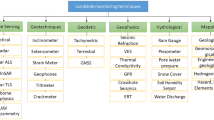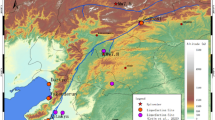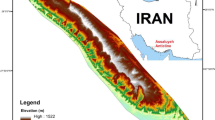Abstract
This study assessed the mechanisms and agents that have contributed to the formation and expansion of earth fissures along the route of the Haram-to-Haram Highway in Iran. To this end, several geological and geotechnical approaches were used, including comprehensive field investigations, in situ tests, soil sampling, and laboratory assessments. Results showed that a combination of shallow and deep mechanisms and various geoenvironmental agents contributed to fissure formation and expansion in the study area, with soil characteristics playing a significant part in the fissuring. This study indicated that earth fissuring is an ongoing problem in the study area that endangers the safety of highway traffic. However, some applicable remedial measures that could mitigate the problem and protect the highway from the adverse consequences of the earth fissuring are also proposed herein.




(Derived from GSI 2006)
















Similar content being viewed by others
References
Abbasi N, Nazifi MH (2013) Assessment and modification of sherard chemical method for evaluation of dispersion potential of soils. Geotech Geol Eng 31(1):337–346
Arizona Geological Survey (2007) Land subsidence and earth fissures in Arizona. Research and informational needs for effective risk management. Arizona Land Subsidence Group (ALSG)/Arizona Geological Survey, Tucson
ASTM (2003) D5333-03: Standard test method for measurement of collapse potential of soils. ASTM International, West Conshohocken
ASTM (2007) D422-63: Standard test method for particle-size analysis of soils. ASTM International, West Conshohocken
ASTM (2009) D6951: Standard test method for use of the dynamic cone penetrometer in shallow pavement applications. Annual Book of ASTM Standards, West Conshohocken
ASTM (2010a) D2216-10: Standard test methods for laboratory determination of water (moisture) content of soil and rock by mass. ASTM International, West Conshohocken
ASTM (2010b) D4318: Standard test methods for liquid limit, plastic limit, and plasticity index of soils. ASTM International, West Conshohocken
ASTM (2011a) D4221-11 Standard test method for dispersive characteristics of clay soil by double hydrometer. ASTM International, West Conshohocken
ASTM (2011b) D3080M-11: Standard test method for direct shear test of soils under consolidated drained conditions. ASTM International, West Conshohocken
ASTM (2012) D698-12: Standard test methods for laboratory compaction characteristics of soil using standard effort (12 400 ft-lbf/ft3 (600 kN-m/m3)). ASTM International, West Conshohocken
ASTM (2013) D4647/D4647M-13: Standard test methods for identification and classification of dispersive clay soils by the pinhole test. ASTM International, West Conshohocken
Ayalew L, Yamagishi H, Reik G (2004) Ground cracks in Ethiopian Rift Valley: facts and uncertainties. Eng Geol 75:309–324
Boardman DI, Glendinning S, Rogers CFD (2001) Development of stabilization and solidification in lime–clay mixes. Geotechnique 51:533–543
Borchers JW, Carpenter M (2014) Land subsidence from groundwater use in California. California Water Foundation, Sacramento
Boucher SG (1990) Field tunnel erosion: its characteristics and amelioration. Monash University, Clayton
Card GB, Roche DP, Herbert SM (1990) Application of continuous dynamic probing in ground investigation. Engineering geology special publication no. 6. Geological Society, London, pp 129–135
Carpenter MC (1993) Earth fissure movements associated with fluctuations in groundwater levels near the Picacho Mountains, south-central Arizona, 1980–84. US Geological Survey professional paper 497-H. US Geological Survey, Washington, DC
Charles I, Herrier G, Chevalier C, Durand E, Puiatti D, Fleureau JM, Taibi S, Bonelli S, Fry JJ (2014) A real scale experimental dike in lime-treated soil: valuation of the methodology, mechanical and hydraulic performance. In: Cheng L, Draper S, An H (eds) Scour and erosion. Taylor and Francis, London
De Ridder NA, Erez A (1977) Description of the Varamin plain (Chap. 2). In: Optimum use of water resources. International Institute for Land Reclamation and Improvement/ILRI, Wageningen
Dušan B, Zoran B, Čebašek V, Šušić N (2014) Characterisation of collapsing loess by seismic dilatometer. Eng Geol 181:180–189
El Howayek A, Huang P, Bisnett R, Santagata MC (2011) Identification and behavior of collapsible soils. Publication FHWA/IN/JTRP-2011/12. Joint Transportation Research Program, Indiana Department of Transportation and Purdue University, West Lafayette. doi:10.5703/1288284314625
Fakher A, Khodaparast M, Jones CJFP (2006) The use of the Mackintosh Probe for site investigation in soft soils. Q J Eng Geol Hydroge 39:189–196
Faulkner H (2006) Piping hazard on collapsible and dispersive soils in Europe. In: Boardman J, Poesen J (eds) Soil erosion in Europe. Wiley, Chichester, pp 537–562
Feng SJ, Tan K, Shui WH, Zhang Y (2013) Densification of desert sands by high energy dynamic compaction. Eng Geol 157:48–54
Feng SJ, Du FL, Shi ZM, Shui WH, Tan K (2015) Field study on the reinforcement of collapsible loess using dynamic compaction. Eng Geol 185:105–115
Galloway DL, Jones DR, Ingebritsen SE (1999) Land subsidence in the United States. US Geological Survey circular 1182. US Geological Survey, Reston, p 177
Galvao TB, Elsharief A, Simoes GF (2004) Effects of lime on permeability and compressibility of two tropical residual soils. J Environ Eng–ASCE 130(8):881–885
Gavver EK (2012) Geotechnical properties of Egyptian collapsible soils. Alex Eng J 51:205–210
Ghazifard A, Moslehi A, Safaei H, Roostaei M (2016) Effects of groundwater withdrawal on land subsidence in Kashan Plain, Iran. Bull Eng Geol Environ 75:1157–1168
GSI (2006) Geological map of the Varamin 1:100,000 Quadrangle. Geological Survey of Iran
Hashemi M, Nikudel MR (2016) Application of dynamic cone penetrometer test for assessment of liquefaction potential. Eng Geol 208:51–62
Herrier G, Berger E, Bonelli S (2012) The Friant–Kern canal: a forgotten example of lime-treated structure in hydraulic conditions. In: 6th Int Conf on Scour and Erosion (ICSE 6), Paris, France, 27–31 Aug 2012, pp 1527–1534
Li X, Wang SJ, Liu TY, Ma FS (2004) Engineering geology, ground surface movement and fissures induced by underground mining in the Jinchuan Nickel Mine. Eng Geol 76:93–107
Li P, Vanapalli S, Li T (2016) Review of collapse triggering mechanism of collapsible soils due to wetting. J Rock Mech Geotech Eng 8:256–274
Mahmoudpour M, Khamehchiyan M, Nikudel MR, Ghassemi MR (2013) Characterization of regional land subsidence induced by groundwater withdrawals in Tehran, Iran. J Geope 3(2):49–62
Mahmoudpour M, Khamehchiyan M, Nikudel MR, Ghassemi MR (2016) Numerical simulation and prediction of regional land subsidence caused by groundwater exploitation in the southwest plain of Tehran, Iran. Eng Geol 201:6–28
Makki-Szymkiewicz L, Hibouche A, Taibi S, Herrier G, Lesueur D, Fleureau JM (2015) Evolution of the properties of lime-treated silty soil in a small experimental embankment. Eng Geol 191:8–22
Maroof MA, Bolouri Bazaz J (2015) Modification and improvement of collapsible soils. J Eng Geol 8(4):2513–2536
Moravvej K, Sarmadian F, Mahmoodi Sh (2004) Classification and mapping of Varamin plain soils using satellite images derived from T.M. sensors. Iran J Natural Res 56(3):177–189
Motagh M, Walter TR, Sharifi MA, Fielding E, Schenk A, Anderssohn J, Zschau J (2008) Land subsidence in Iran caused by widespread water reservoir overexploitation. Geophys Res Lett 35:L16403. doi:10.1029/2008GL033814
Mousavi SM, Shamsai A, El Naggar MH, Khamehchian M (2001) A GPS-based monitoring program of land subsidence due to groundwater withdrawal in Iran. Can J Civil Eng 28:452–464
National Lime Association (2006) Mixture design and testing procedures for lime stabilized soil. National Lime Association, Arlington
Peng J, Qiao J, Leng Y, Wang F, Xue S (2016) Distribution and mechanism of the ground fissures in Wei River Basin, the origin of the Silk Road. Environ Earth Sci 75:718
Petry TM, Berger EA (2006) Impact of moisture content on strength gain in lime-treated soils (paper 06-2764). In: 85th Annual Meeting of the Transportation Research Board, Washington, DC, USA, 22–26 Jan 2006, p 16
Rollins KM, Jihyoung Kim PE (2010) Dynamic compaction of collapsible soils based on U.S. case histories. J Geotech Geoenviron Eng 136(9):1178–1186
Romero EN, Verachtert E, Maes R, Poesen J (2011) Quantitative assessment of the piping erosion susceptibility of loess-derived soil horizons using the pinhole test. Geomorphology 135:66–79
Sahu P, Sikdar PK (2011) Threat of land subsidence in and around Kolkata City and East Kolkata Wetlands, West Bengal, India. J Earth Syst Sci 120(3):435–446
Sarkar I (2004) The role of the 1999 Chamoli Earthquake in the formation of ground cracks. J Asian Earth Sci 22:529–538
Schenk A (2006) Interpreting surface displacement in Tehran/Iran region observed by differential synthetic aperture radar interferometry (DINSAR). Diplomarbeit Technische. Universität Berlin, Berlin
Sherard JL, Dunnigan LP, Decker RS (1976) Identification and natures of dispersive soils. J Geotech Eng Div 102(4):287–301
Sun P, Peng J, Chen L, Yin Y, Wu S (2009) Weak tensile characteristics of loess in China—an important reason for ground fissures. Eng Geol 108:153–159
Sun P, Peng J, Chen L, Lu Q, Igwe O (2016) An experimental study of the mechanical characteristics of fractured loess in western China. Bull Eng Geol Environ 75:1639. doi:10.1007/s10064-015-0793-y
Terranova C, Ventura G, Vilardo G (2015) Multiple causes of ground deformation in the Napoli metropolitan area (Italy) from integrated persistent scatterers DinSAR, geological, hydrological, and urban infrastructure data. Earth Sci Rev 146:105–119
Vaz T, Zezere JL (2016) Landslides and other geomorphologic and hydrologic effects induced by earthquakes in Portugal. Nat Hazards 81:71–98
Verachtert E, Eeckhaut MVD, Poesen J, Govers G, Deckers J (2011) Prediction of spatial patterns of collapsed pipes in loess-derived soils in a temperate humid climate using logistic regression. Geomorphology 130:185–196
Verachtert E, Eeckhaut MVD, Martínez-Murillo JF, Romero EN, Poesen J, Devoldere S, Wijnants N, Deckers J (2013) Impact of soil characteristics and land use on pipe erosion in a temperate humid climate: field studies in Belgium. Geomorphology 192:1–14
Wang GY, You G, Shi B, Yu J, Li HY, Zong KH (2009) Earth fissures triggered by groundwater withdrawal and coupled by geological structures in Jiangsu province, China. Environ Geol 57:1047–1054
Wang GY, You G, Shi B, Qiu ZL, Li HY, Tuck M (2010) Earth fissures in Jiangsu Province, China and geological investigation of Hetang earth fissure. Environ Earth Sci 60:35–43
Xu YS, Shen SL, Cai ZY, Zhou GY (2008) The state of land subsidence and prediction approaches due to groundwater withdrawal in China. Nat Hazards 45(1):123–135
Xu J, Meng L, An H, Wang L (2015) The bending mechanism of Anping ground fissure in the Hebei Plain, North China. Environ Earth Sci 74:6859–6870. doi:10.1007/s12665-015-4670-6
Xu L, Li S, Cao X, Somerville ID, Suo Y, Liu X, Dai L, Zhao S, Guo L, Wang P, Cao H (2016) Holocene intracontinental deformation of the northern North China Plain: evidence of tectonic ground fissures. J Asian Earth Sci 119:49–64
Youssef AM, Sabtan AA, Maerz NH, Zabramawi YA (2014) Earth fissures in Wadi Najran, Kingdom of Saudi Arabia. Nat Hazards 71:2013–2027
Zhang Y, Xue YQ, Wu JC, Shi XQ, Yu J (2010) Excessive groundwater withdrawal and resultant land subsidence in the Su-Xi-Chang area, China. Environ Earth Sci 61(6):1135–1143
Zimbardo M, Ercoli L, Megna B (2016) The open metastable structure of a collapsible sand: fabric and bonding. Bull Eng Geol Environ 75:125–139
Author information
Authors and Affiliations
Corresponding author
Rights and permissions
About this article
Cite this article
Nikbakhti, O., Hashemi, M., Banikheir, M. et al. Geoenvironmental assessment of the formation and expansion of earth fissures as geological hazards along the route of the Haram-to-Haram Highway, Iran. Bull Eng Geol Environ 77, 1421–1438 (2018). https://doi.org/10.1007/s10064-017-1019-2
Received:
Accepted:
Published:
Issue Date:
DOI: https://doi.org/10.1007/s10064-017-1019-2




